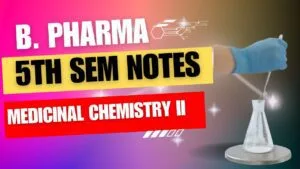Medicinal Chemistry II – B. Pharma 5th Semester Notes Pdf

Scope: This subject Medicinal Chemistry is designed to impart fundamental knowledge on the structure, chemistry, and therapeutic value of drugs. The subject emphasizes on structure-activity relationships of drugs, the importance of physicochemical properties, and the metabolism of drugs. The syllabus also emphasizes on the chemical synthesis of important drugs in each class.
Objectives: Upon completion of the course the student shall be able to
1. Understand the chemistry of drugs with respect to their pharmacological activity
2. Understand the drug metabolic pathways, adverse effect,s and therapeutic value of drugs
3. Know the Structural Activity Relationship of different classes of drugs
4. Study the chemical synthesis of selected drugs
Course Content:
Study of the development of the following classes of drugs, Classification, mechanism of action, uses of drugs mentioned in the course, Structure-activity relationship of the selective class of drugs as specified in the course, and synthesis of drugs superscripted (*)
Medicinal Chemistry UNIT- I
Antihistaminic agents: Histamine, receptors and their distribution in the human body
H1–antagonists: Diphenhydramine hydrochloride*, Dimenhydrinate, Doxylamine succinate, Clemastine fumarate, Diphenylphyraline hydrochloride, Tripelenamine hydrochloride, Chlorcyclizine hydrochloride, Meclizine hydrochloride, Buclizine hydrochloride, Chlorpheniramine maleate, Triprolidine hydrochloride*, Phenidamine tartrate, Promethazine hydrochloride*, Trimeprazine tartrate, Cyproheptadine hydrochloride, Azatidine maleate, Astemizole, Loratadine, Cetirizine, Levocetirizine Cromolyn sodium
H2-antagonists: Cimetidine*, Famotidine, Ranitidine.
Gastric Proton pump inhibitors: Omeprazole, Lansoprazole, Rabeprazole, Pantoprazole
Alkylating agents: Mechlorethamine*, Cyclophosphamide, Melphalan, Chlorambucil, Busulfan, Thiotepa
Antimetabolites: Mercaptopurine*, Thioguanine, Fluorouracil, Floxuridine, Cytarabine, Methotrexate*, Azathioprine
Antibiotics: Dactinomycin, Daunorubicin, Doxorubicin, Bleomycin
Plant products: Etoposide, Vinblastin sulfate, Vincristine sulfate
Miscellaneous: Cisplatin, Mitotane.
Medicinal Chemistry UNIT – II
Vasodilators: Amyl nitrite, Nitroglycerin*, Pentaerythritol tetranitrate, Isosorbide dinitrite*, Dipyridamole.
Calcium channel blockers: Verapamil, Bepridil hydrochloride, Diltiazem hydrochloride, Nifedipine, Amlodipine, Felodipine, Nicardipine, Nimodipine.
Carbonic anhydrase inhibitors: Acetazolamide*, Methazolamide, Dichlorphenamide.
Thiazides: Chlorthiazide*, Hydrochlorothiazide, Hydroflumethiazide, Cyclothiazide,
Loop diuretics: Furosemide*, Bumetanide, Ethacrynic acid.
Potassium sparing Diuretics: Spironolactone, Triamterene, Amiloride. Osmotic Diuretics: Mannitol
Anti-hypertensive Agents: Timolol, Captopril, Lisinopril, Enalapril, Benazepril hydrochloride, Quinapril hydrochloride, Methyldopate hydrochloride,* Clonidine hydrochloride, Guanethidine monosulphate, Guanabenz acetate, Sodium nitroprusside, Diazoxide, Minoxidil, Reserpine, Hydralazine hydrochloride.
Medicinal Chemistry UNIT- III
Anti-arrhythmic Drugs: Quinidine sulphate, Procainamide hydrochloride, Disopyramide phosphate*, Phenytoin sodium, Lidocaine hydrochloride, Tocainide hydrochloride, Mexiletine hydrochloride, Lorcainide hydrochloride, Amiodarone, Sotalol.
Anti-hyperlipidemic agents: Clofibrate, Lovastatin, Cholesteramine, and Cholestipol
Coagulant & Anticoagulants: Menadione, Acetomenadione, Warfarin*, Anisindione, clopidogrel
Drugs used in Congestive Heart Failure: Digoxin, Digitoxin, Nesiritide, Bosentan, Tezosentan.
Medicinal Chemistry UNIT- IV
Drugs Acting on Endocrine System: Nomenclature, Stereochemistry, and metabolism of steroids
Sex hormones: Testosterone, Nandralone, Progestrones, Oestriol, Oestradiol, Oestrione, Diethyl stilbestrol.
Drugs for erectile dysfunction: Sildenafil, Tadalafil.
Oral contraceptives: Mifepristone, Norgestril, Levonorgestrol
Corticosteroids: Cortisone, Hydrocortisone, Prednisolone, Betamethasone, Dexamethasone
Thyroid and antithyroid drugs: L-Thyroxine, L-Thyronine, Propylthiouracil, Methimazole.
Medicinal Chemistry UNIT – V
Antidiabetic agents: Insulin and its preparations
Sulfonyl ureas: Tolbutamide*, Chlorpropamide, Glipizide, Glimepiride.
Biguanides: Metformin.
Thiazolidinediones: Pioglitazone, Rosiglitazone.
Meglitinides: Repaglinide, Nateglinide.
Glucosidase inhibitors: Acrabose, Voglibose.
Local Anesthetics: SAR of Local Anesthetics
Benzoic Acid derivatives; Cocaine, Hexylcaine, Meprylcaine, Cyclomethycaine, Piperocaine.
Amino Benzoic acid derivatives: Benzocaine*, Butamben, Procaine*, Butacaine, Propoxycaine, Tetracaine, Benoxinate.
Lidocaine/Anilide derivatives: Lignocaine, Mepivacaine, Prilocaine, Etidocaine.
Miscellaneous: Phenacaine, Diperodon, Dibucaine.*
Medicinal Chemistry 5th sem Notes
Medicinal Chemistry 2 Short Notes:
Antihistaminic Agents:
Antihistaminic agents are drugs that block the effects of histamine, a chemical involved in allergic reactions.
They are used to treat allergies, hay fever, itching, and other allergic conditions.
Examples of antihistaminic agents include diphenhydramine, cetirizine, loratadine, and fexofenadine.
H2-Antagonists:
H2-antagonists, also known as H2 blockers, are drugs that reduce the production of stomach acid.
They are used to treat conditions such as gastric ulcers, gastroesophageal reflux disease (GERD), and excessive stomach acid production.
Examples of H2-antagonists include ranitidine, famotidine, and cimetidine.
Gastric Proton Pump Inhibitors:
Gastric proton pump inhibitors (PPIs) are drugs that suppress the production of gastric acid by blocking the enzyme responsible for acid secretion.
They are used to treat conditions such as peptic ulcers, GERD, and gastric hyperacidity.
Examples of PPIs include omeprazole, esomeprazole, and lansoprazole.
Anti-Neoplastic Agents:
Anti-neoplastic agents, also known as anticancer drugs, are medications used to treat various types of cancer.
They work by inhibiting the growth and spread of cancer cells.
Examples of anti-neoplastic agents include cisplatin, doxorubicin, paclitaxel, and imatinib.
Anti-Anginal Agents:
Anti-anginal agents are drugs used to treat angina, a condition characterized by chest pain or discomfort caused by reduced blood flow to the heart.
They work by dilating blood vessels, improving blood flow, and reducing the workload on the heart.
Examples of anti-anginal agents include nitroglycerin, beta-blockers, and calcium channel blockers.
Drugs Acting on the Endocrine System:
Drugs acting on the endocrine system are medications that regulate hormonal function in the body.
They are used to treat various endocrine disorders, such as thyroid disorders, adrenal gland disorders, and hormone-related conditions.
Examples of drugs acting on the endocrine system include levothyroxine, glucocorticoids, insulin, and hormonal contraceptives.
Antidiabetic Agents:
Antidiabetic agents are drugs used to manage diabetes mellitus, a chronic metabolic disorder characterized by high blood sugar levels.
They help regulate blood sugar levels and improve insulin action.
Examples of antidiabetic agents include metformin, sulfonylureas, insulin, and thiazolidinediones.
Local Anesthetics:
Local anesthetics are drugs that induce reversible loss of sensation in a specific area of the body.
They are used to numb an area before medical procedures or surgeries.
Examples of local anesthetics include lidocaine, procaine, and bupivacaine.
Medicinal Chemistry Recommended Books (Latest Editions)
1. Wilson and Giswold’s Organic medicinal and Pharmaceutical Chemistry.
2. Foye’s Principles of Medicinal Chemistry.
3. Burger’s Medicinal Chemistry, Vol I to IV.
4. Introduction to principles of drug design- Smith and Williams.
5. Remington’s Pharmaceutical Sciences.
6. Martindale’s extra pharmacopoeia.
7. Organic Chemistry by I.L. Finar, Vol. II.
8. The Organic Chemistry of Drug Synthesis by Lednicer, Vol. 1to 5.
9. Indian Pharmacopoeia.
10. Textbook of practical organic chemistry- A.I.Vogel.
